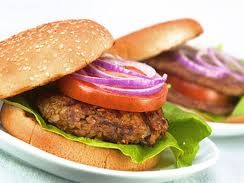Australian industry digs deep for Japan
 MLA Chairman Don Heatley and Japan regional manager Melanie Brock visited Tsunami-affected Japanese regions last Wednesday.
MLA Chairman Don Heatley and Japan regional manager Melanie Brock visited Tsunami-affected Japanese regions last Wednesday.
During the visit Mr Heatley announced that the charity barbeque held earlier in Sydney by MLA to support Japan's earthquake reconstruction had raised ¥20 million (about A$250,000) in donations, according to local reports.
Local press said Mr Heatley pledged to supply hay to cattle farmers affected by the disaster and would set up an educational scholarship.
Mr Heatley and Ms Brock visited Iitate village and Rikuzentakata city where they reunited with three Tsunami-affected livestock producers who attended MLA's earlier charity barbeque.
During an Australian beef forum in Tokyo later in the week, Australian ambassador to Japan Murray McLean joined Mr Heatley and Ms Brock in speaking about the relationship between Japan and Australia, Australia's meat industry, the global supply-demand situation and MLA's plans to support Japan's reconstruction effort. During the reception, Makoto Yamada, one of the livestock producers who visited Australia, thanked MLA for providing support.
Big lift in US feedlot numbers
US cattle on feed placements during April surged 9.9pc year-on-year, to 1.8 million head, well above industry expectations.
The surge in placements for April takes total US feedlot inventories in May to 11.2 million head – 7pc ahead of the same period last year, according to the USDA. That’s the twelfth successive month in which cattle on feed numbers have been larger than a year earlier.
While the higher feeder numbers this year can be partly attributed to a rise in young cattle coming out of Mexico, they are largely the result of worsening drought conditions (see report below) forcing ranchers in southern states to increase cattle turnoff. That has driven-up feedlot placements.
The higher feedlot inventory for May is remarkable, as it coincides with higher corn prices, a shrinking US herd and the lowest calf-crop in decades. All that points to fewer available feeder cattle in coming months, according to the Daily Livestock Report. While the current increased numbers on feed will assist beef production over the short term, it will further accentuate an already relatively tight US beef supply chain into 2012.
Brazil feedlots aim to increase numbers by 31pc
Projections from the Brazil Lotfeeders’ Association (Assocon), suggest the number of animals likely to be grain-finished in Brazil will increase 31pc next financial year.
Estimates are based on a survey from 61 grainfed producers in 11 Brazilian states.
Assocon says the projection will depend on favourable market conditions throughout the year.
US grows in EU Grainfed Beef
The US Meat Export Federation has suggested that shipments against the new 20,000 tonne EU grainfed beef quota have been much better than expected. USMEF originally projected shipments would reach 12,000-14,000 tonnes for the current quota year, ending June 30.
But based on current data, shipments against the quota will be closer to 16,500t.
Given Australia has exported only 3700t in this quota year, that forecast would suggest that the 20,000t quota will be largely filled this year, MEF says.
Highlighting the attractive tariff-free nature of the new grainfed quota, the US and Canada have hardly touched their EU HQB (equivalent to Australia’s grassfed Hilton) quota of 11,500t, which attracts 20pc tariff.
Odd spot:
 Making news around the world last week, for all the wrong reasons, was a new Guinness World record for hamburger consumption.
Making news around the world last week, for all the wrong reasons, was a new Guinness World record for hamburger consumption.
A retired prison employee in Wisconsin in the US consumed his 25,000th McDonald’s Big Mac, marking the culinary milestone 39 years to-the-day after he ate his first. He has averaged two Big Macs a day and the slim 59-year-old has kept receipts and burger cartons to prove his record.
A doctor reportedly recently gave him a clean bill of health and his cholesterol is said to be low.
US hard-hit by weather
Weather in the US has been making a complicated 2011 cattle market even cloudier, ultimately affecting everyone from producers to consumers.
"Just about everything has been affected, from supply impacts to demand inputs to input market impacts," said Derrell Peel, Oklahoma State University extension livestock marketing specialist.
But perhaps the most difficult assessment is the effect weather continues to have on the supply side of the US cattle market, both in the short and long term.
"Certainly, limited feeder supplies will maintain upward pressure on feeder-cattle prices, but the question of just how much pressure depends on the bigger question of herd rebuilding," Mr Peel said.
"That question, in turn, depends on what the industry is trying to do as well as what Mother Nature will permit us to do."
Both beef cow and beef heifer replacement numbers increased in the northern Great Plains and Rocky Mountains. With good moisture conditions, these areas are expected to continue herd expansion in 2011.
However beef cow numbers at the beginning of the year decreased sharply in Missouri, Iowa, Kentucky, Louisiana, Texas and Oklahoma. Some analysts suspect that in the first three states the decline may reflect increasing competition with crop production and long-term shifts away from beef production. It will be some time before such impacts can be confirmed.
In the other states, the decrease reflects continuing drought conditions that have spread from Louisiana and eastern Texas across much of Texas and parts of Oklahoma, New Mexico and eastern Colorado this year.
